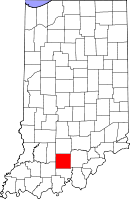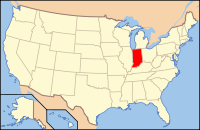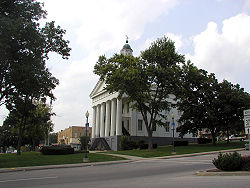- Orange County, Indiana
-
For other uses, see Orange County (disambiguation).
Orange County, Indiana 
Location in the state of Indiana
Indiana's location in the U.S.Founded 1816 Seat Paoli Area
- Total
- Land
- Water
408.19 sq mi (1,057 km²)
398.39 sq mi (1,032 km²)
9.80 sq mi (25 km²), 2.40%Population
- (2010)
- Density
19,840
50/sq mi (19.17/km²)Congressional district 9th Website www.orangecountyindiana.info Footnotes: Indiana county number 59
Orange County is a county located in the U.S. state of Indiana. As of 2010, the population was 19,840.[1] The county seat is Paoli[2].
Contents
Climate and weather
Paoli, Indiana Climate chart (explanation) J F M A M J J A S O N D 3.338183.144224.455314.865405.175504.283604.587644.285623.379532.968404.255323.64323Average max. and min. temperatures in °F Precipitation totals in inches Source: The Weather Channel[3] Metric conversion J F M A M J J A S O N D 843-8797-611113-1123184131241010628161133118106291783261274204107130926-5Average max. and min. temperatures in °C Precipitation totals in mm In recent years, average temperatures in Paoli have ranged from a low of 18 °F (−8 °C) in January to a high of 87 °F (31 °C) in July, although a record low of −29 °F (−34 °C) was recorded in January 1994 and a record high of 111 °F (44 °C) was recorded in July 1901. Average monthly precipitation ranged from 2.90 inches (74 mm) in October to 5.14 inches (131 mm) in May.[3]
Government
The county government is a constitutional body, and is granted specific powers by the Constitution of Indiana, and by the Indiana Code.
County Council: The county council is the legislative branch of the county government and controls all the spending and revenue collection in the county. Representatives are elected from county districts. The council members serve four year terms. They are responsible for setting salaries, the annual budget, and special spending. The council also has limited authority to impose local taxes, in the form of an income and property tax that is subject to state level approval, excise taxes, and service taxes.[4][5]
Board of Commissioners: The executive body of the county is made of a board of commissioners. The commissioners are elected county-wide, in staggered terms, and each serves a four-year term. One of the commissioners, typically the most senior, serves as president. The commissioners are charged with executing the acts legislated by the council, collecting revenue, and managing the day-to-day functions of the county government.[4][5]
Court: The county maintains a small claims court that can handle some civil cases. The judge on the court is elected to a term of four years and must be a member of the Indiana Bar Association. The judge is assisted by a constable who is also elected to a four-year term. In some cases, court decisions can be appealed to the state level circuit court.[5]
County Officials: The county has several other elected offices, including sheriff, coroner, auditor, treasurer, recorder, surveyor, and circuit court clerk Each of these elected officers serves a term of four years and oversees a different part of county government. Members elected to county government positions are required to declare party affiliations and to be residents of the county.[5] Orange County is part of Indiana's 9th congressional district and is represented in Congress by Democrat Baron Hill.[6]
Geography
According to the 2010 census, the county has a total area of 408.19 square miles (1,057.2 km2), of which 398.39 square miles (1,031.8 km2) (or 97.60%) is land and 9.80 square miles (25.4 km2) (or 2.40%) is water.[7]
Adjacent counties
- Lawrence County (north)
- Washington County (east)
- Crawford County (south)
- Dubois County (southwest)
- Martin County (northwest)
Major highways
 U.S. Route 150
U.S. Route 150 Indiana State Road 37
Indiana State Road 37 Indiana State Road 56
Indiana State Road 56 Indiana State Road 60
Indiana State Road 60 Indiana State Road 145
Indiana State Road 145 Indiana State Road 337
Indiana State Road 337
National protected area
- Hoosier National Forest (part)
History
Orange County was formed from parts of Knox, Gibson and Washington Counties in 1816. The County Seat is at Paoli.
The early settlers were mostly Quakers fleeing the institution of slavery in Orange County, North Carolina. Jonathan Lindley brought his group of Quakers from North Carolina to the area in 1811. Under Lindley’s leadership, they were the first to build a religious structure, the Lick Creek Meeting House in 1813. It was from this group that Orange County got its name. [1][8]
(See List of Indiana county name etymologies). The name Orange derives from the Dutch Protestant House of Orange, which acquired the English throne with the accession of King William III in 1689, following the Glorious Revolution.
In the early 19th century when the Quakers came from North Carolina to settle in Orange County, Indiana, they came to escape slavery. They brought with them a number of freed slaves. These free men were deeded 200 acres (0.81 km2) of land in the heart of a dense forest. Word of mouth soon spread the news, and this land became part of the "underground railroad" for runaway slaves.
For many years, the freed slaves in this area farmed, traded, and sold their labor to others while living in this settlement. A church was built and a cemetery was provided for their loved ones.
All that remains today is the cemetery. Some of the stones were broken or vandalized over the years. Several years ago, a troop of Boy Scouts came in and restored the cemetery, replacing the lost or broken stones with wooden crosses designating a grave. The name of "Little Africa" came about because of the black settlement, but "Paddy's Garden" was the name those early residents called it.
Demographics
Historical populations Census Pop. %± 1820 5,368 — 1830 7,901 47.2% 1840 9,602 21.5% 1850 10,809 12.6% 1860 12,076 11.7% 1870 13,497 11.8% 1880 14,363 6.4% 1890 14,678 2.2% 1900 16,854 14.8% 1910 17,192 2.0% 1920 16,974 −1.3% 1930 17,459 2.9% 1940 17,311 −0.8% 1950 16,879 −2.5% 1960 16,877 0% 1970 16,968 0.5% 1980 18,677 10.1% 1990 18,409 −1.4% 2000 19,306 4.9% 2010 19,840 2.8% Sources: United States Department of Commerce,
Bureau of the Census, Population Division[9]
Census Quickfacts[1]As of the census[10] of 2000, there were 19,306 people, 7,621 households, and 5,342 families residing in the county. The population density was 48 people per square mile (19/km²). There were 8,348 housing units at an average density of 21 per square mile (8/km²). The racial makeup of the county was 97.90% White, 0.63% Black or African American, 0.31% Native American, 0.17% Asian, 0.01% Pacific Islander, 0.25% from other races, and 0.73% from two or more races. 0.56% of the population were Hispanic or Latino of any race. 38.0% were of American, 18.1% German, 11.8% English and 10.3% Irish ancestry according to Census 2000.
There were 7,621 households out of which 32.40% had children under the age of 18 living with them, 57.60% were married couples living together, 8.60% had a female householder with no husband present, and 29.90% were non-families. 26.20% of all households were made up of individuals and 12.00% had someone living alone who was 65 years of age or older. The average household size was 2.49 and the average family size was 3.00.
In the county the population was spread out with 25.70% under the age of 18, 8.00% from 18 to 24, 28.00% from 25 to 44, 23.50% from 45 to 64, and 14.90% who were 65 years of age or older. The median age was 38 years. For every 100 females there were 96.70 males. For every 100 females age 18 and over, there were 94.70 males.
The median income for a household in the county was $31,564, and the median income for a family was $38,505. Males had a median income of $28,658 versus $20,238 for females. The per capita income for the county was $16,717. About 9.00% of families and 12.40% of the population were below the poverty line, including 16.10% of those under age 18 and 12.90% of those age 65 or over.
Education
The county is served by 4 school districts[11]:
- Lost River Career Cooperative
- Orleans Community Schools
- Paoli Community School Corporation
- Springs Valley Community School Corporation.
Orleans Community Schools (Superintendent:James Terrell[12]) includes[12]:
- Orleans Elementary School (Principal:Roy Kline[12])
- Orleans Jr./Sr. High School (Principal:Gary McClintic[12]).
Paoli Community Schools (Superintendent:Dr. Victor Combs.)includes:
- Throop Elementary School (Principal:Sharon R. Tucker)
- Paoli Jr./Sr. High School (Principal:Casey Brewster).
Springs Valley School Corporation (Superintendent: Todd Pritchett) includes:
- Springs Valley Elementary School (Principal:Tony Whitaker)
- Springs Valley Jr./Sr. High School (Principal: Troy Pritchett)
Cities and towns
Townships
- French Lick
- Greenfield
- Jackson
- Northeast
- Northwest
- Orangeville
- Orleans
- Paoli
- Southeast
- Stampers Creek
See also
External links
References
- ^ a b "Orange County QuickFacts". United States Census Bureau. http://quickfacts.census.gov/qfd/states/18/18117.html. Retrieved 2011-09-25.
- ^ "Find a County". National Association of Counties. http://www.naco.org/Counties/Pages/FindACounty.aspx. Retrieved 2011-06-07.
- ^ a b "Monthly Averages for Paoli, Indiana". The Weather Channel. http://www.weather.com/weather/wxclimatology/monthly/graph/USIN0515. Retrieved 2011-01-27.
- ^ a b Indiana Code. "Title 36, Article 2, Section 3". IN.gov. http://www.in.gov/legislative/ic/code/title36/ar2/ch3.html. Retrieved 2008-09-16.
- ^ a b c d Indiana Code. "Title 2, Article 10, Section 2". IN.gov. http://www.in.gov/legislative/ic/code/title3/ar10/ch2.pdf. Retrieved 2008-09-16.
- ^ "Conressman Baron Hill". House.Gov. http://baronhill.house.gov/district.shtml. Retrieved 2008-09-12.
- ^ "Census 2010 U.S. Gazetteer Files: Counties". United States Census. http://www.census.gov/geo/www/gazetteer/files/Gaz_counties_national.txt. Retrieved 2011-10-10.
- ^ De Witt Clinton Goodrich & Charles Richard Tuttle (1875). An Illustrated History of the State of Indiana. Indiana: R. S. Peale & co.. pp. 569. http://books.google.com/books?id=YDIUAAAAYAAJ.
- ^ Forstall, Richard L. (editor) (1996). Population of states and counties of the United States: 1790 to 1990 : from the twenty-one decennial censuses. United States Department of Commerce, Bureau of the Census, Population Division. pp. 50–53. ISBN 0-934213-48-8. http://books.google.com/books?id=Z12v1lrkv2IC&lpg=PA50&pg=PA50#v=onepage&q&f=false.
- ^ "American FactFinder". United States Census Bureau. http://factfinder.census.gov. Retrieved 2008-01-31.
- ^ Education, Indiana Department of. "Indiana K-12 School Web Sites". http://mustang.doe.state.in.us/dg/schools/welcome.html. Retrieved 2009-05-29.
- ^ a b c d Schools, Orleans Community (2009-05-18). "Welcome to Orleans Community Schools - The Time Is: Current UTC is 13:49". http://www.orleans.k12.in.us/. Retrieved 2009-05-29.

Martin County Lawrence County 

Washington County  Orange County, Indiana
Orange County, Indiana 

Dubois County Crawford County Municipalities and communities of Orange County, Indiana Towns Townships French Lick | Greenfield | Jackson | Northeast | Northwest | Orangeville | Orleans | Paoli | Southeast | Stampers Creek
Unincorporated
communitiesAbydel | Bacon | Bonds | Bromer | Chambersburg | Ethel | Fargo | Greenbrier | Hindostan | Leipsic | Millersburg | Newton Stewart | Norton | Orangeville | Pearsontown | Pine Valley | Prospect | Pumpkin Center | Rego | Roland | Scarlet | Syria | Valeene | Woodlawn Grove | Youngs Creek
Categories:- Indiana counties
- Orange County, Indiana
- 1816 establishments in the United States
- Populated places established in 1816
Wikimedia Foundation. 2010.


